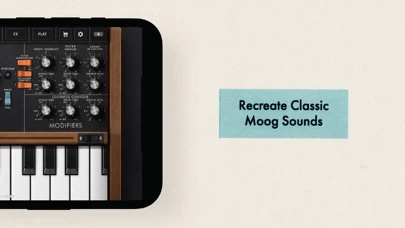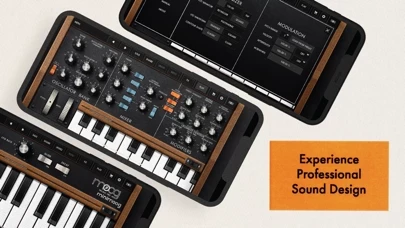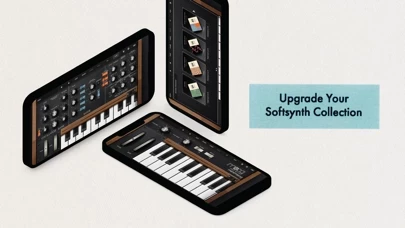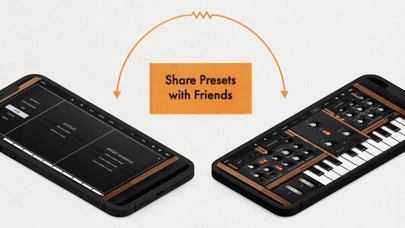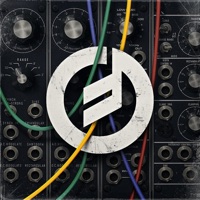
Minimoog Model D Synthesizer Software
Firmenname: Moog Music Inc.
Über: Home to all Moog software to expand your sound.
Hauptsitz: Asheville, North Carolina, United States.
Minimoog Model D Synthesizer Übersicht
New functions include the ability to play chords with up to four-note polyphony, an easy-to-use arpeggiator for rhythmic pattern creation, a real time looping recorder with unlimited overdubbing capacity, a tempo-synchronizable stereo ping pong delay module, and the Bender -- a wide-range stereo time modulation effect module.
Taking full advantage of the iOS platform, the Minimoog Model D App incorporates a number of inspiring sound creation tools and capabilities not present on its analog antecedent.
The Minimoog Model D App also supports AUv3 Audio Unit extensions, which allows multiple instances of this powerful instrument to be used simultaneously within compatible iOS apps like Apple’s GarageBand®.
The classic sound of the Minimoog Model D can be heard on Bob Marley’s Catch A Fire, Michael Jackson’s Thriller and Dr.
Bernie Worrell used the Minimoog Model D to establish Parliament Funkadelic’s futuristic funk sound.
Gary Numan replaced his live band’s guitars with Minimoog Model Ds, creating the prototype for industrial music.
Introduced by Moog in 1970, the Minimoog Model D served as the archetype for all electronic keyboards that followed.
Kraftwerk employed the Minimoog Model D on the successful concept album Autobahn, sparking an entirely new genre.
Offizielle Bildschirmfotos
Produkt einzelheiten und Beschreibung von
The Minimoog Model D App is a software transmutation of the world’s first portable synthesizer, the Minimoog Model D®. Anyone can jump in and play with over 160 included presets or lay fingers to the controls and begin exploring vast magical realms of creative potential for iPad, iPhone, iPod Touch and Mac. The Minimoog Model D App incorporates a number of inspiring sound creation tools and capabilities not present on its analog antecedent. New functions include the ability to play chords with up to four-note polyphony, an easy-to-use arpeggiator for rhythmic pattern creation, a real time looping recorder with unlimited overdubbing capacity, a tempo-synchronizable stereo ping pong delay module, and the Bender -- a wide-range stereo time modulation effect module. The Minimoog Model D App also supports AUv3 Audio Unit extensions, which allows multiple instances of this powerful instrument to be used simultaneously within compatible iOS apps supporting AUv3. A BRIEF HISTORY Introduced by Moog in 1970, the Minimoog Model D served as the archetype for all electronic keyboards that followed. It gave users the ability to design their own sounds, translating imagination into reality. The Minimoog’s portability, affordability and accessibility made it the go-to instrument for musicians looking to expand beyond the traditional sounds of the time. Bernie Worrell used the Minimoog Model D to establish Parliament Funkadelic’s futuristic funk sound. Kraftwerk employed the Minimoog Model D on the successful concept album Autobahn, sparking an entirely new genre. Gary Numan replaced his live band’s guitars with Minimoog Model Ds, creating the prototype for industrial music. The classic sound of the Minimoog Model D can be heard on Bob Marley’s Catch A Fire, Michael Jackson’s Thriller and Dr. Dre’s The Chronic; Detailed in the mini-doc series “A Brief History Of The Minimoog”. FEATURES • Ships with over 160 presets (hundreds more available in the Minimoog Model D App Store) • Up to 4-notes of polyphony • Easily share presets and audio recordings with friends • Arpeggiator module with note-hold and chord latch capability • Stereo ping-pong delay effect • Bender time modulation effect • Real-time looping recorder with overdub and immediate sharing • Selectable envelope shapes and triggering behavior • Effortless MIDI CC mapping • Seamlessly backup presets to iCloud • Play mode for easier panel and keyboard interaction • A new take on the classic feedback/overload path SUPPORTS • All 64-bit iOS devices • AUv3 Audio Unit Extensions (Including GarageBand) • MPE Controller Support • Ableton Link • Inter-App Audio and Audiobus • 7 and 14-Bit MIDI • MIDI Program Change Support • Bluetooth LE MIDI controllers • Share over AirDrop, Mail, or other iOS applications
Oben Erfahrungen und Bewertung
durch suomynona
Guter Sound, UI könnte besser sein
An Sound und Funktionalität ist wenig auszusetzen. Der Looper kann aber nur ein undo und ein overdub kann damit nicht zurückgenommen werden. Nicht so schön. Allerdings sind die Beschriftungen zu klein und nicht lesbar. Da hätte ich mir weniger „Holz“ gewünscht und den Platz in größere Buttons und Texte investiert. Da ist wirklich viel Bildschirmglas für sinnlose Holzbottich geopfert worden. Und ich vermisse daher wirklich eine Zoom-Möglichkeit beim Bedienpanel wie beim Model 15 und die anpassbare Klaviatur der Anymoog-App. Da verstehe ich dann nicht, wie ein Anbieter die Features der eigenen Apps nicht gleich in allen Apps integriert. Aber vielleicht gibt es ja noch mal ein Update. Bis dahin fehlt ein Stern.
durch Tai_HD
Fast alles gut
Der Sound stimmt, AUv3 integriert. Manual lesen (integrierte Hilfe über Zahnrad). Dann erfahre ich dass Tip & Drag eines Potis feiner abstuft, wenn ich einen zweiten Finger irgendwo im freien Bereich hinsetze. Wie bei fast allen PlugIns ist die Soundverwaltung nicht optimal. Besser als bei Mitbewerbern, aber mit Luft nach oben. MPE muss ich noch checken, wird aber glaube ich nicht direkt unterstützt.
durch Jo-scho
Besser gehts nicht
Ich kann das meckern nicht nachvollziehen. Leute, schaut auf den Preis und das is gut. Tolle App. Vor allem deshalb weil ich hier meine Preset speichern kann und so live für meinen Original Minimoog Model D eine perfekte Vorlage habe. Der Looper ist cool. Schnell mal eine Basslinie eingespielt und schon kann das üben meiner Solos beginnen. Absolute Kaufempfehlung

